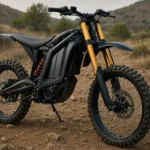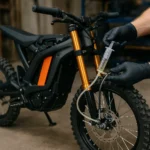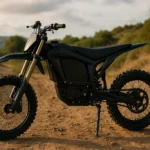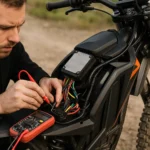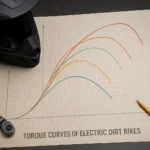Battery capacity electric dirt bike is the #1 factor shaping how far you ride, how hard you push, and how often you recharge. For parents choosing the right setup for their kids or young riders planning epic weekend trails, understanding amp-hours (Ah), watt-hours (Wh), and voltage is essential. A bigger pack can mean more freedom, but the right match also depends on terrain, riding style, and bike weight. 🔋
In this guide, we break down the science behind battery capacity electric dirt bike specs so you can avoid guesswork and make confident decisions. We’ll turn complex terms into clear, rider-friendly tips you can actually use. Whether you want better range, more speed, or just fewer charging breaks, this is where you start.
If top speed matters to you, check our fastest electric dirt bike guide before deciding on a battery—capacity and voltage go hand in hand. 🏍️
Key Takeaways
- Wh beats Ah for comparing batteries across bikes because it includes voltage. 🧠
- Bigger capacity = longer range, but weight, terrain, and throttle habits can shrink it fast. 🏁
- Smart charging and storage can double usable lifespan over time. ♻️
- Match capacity to rider profile: kid beginner ≠ enduro adult. 🧩
⚡ Here’s what you’ll get from this guide: use the quick links below to jump to the section you need most 👇
What Battery Capacity Really Means (Ah vs Wh vs Volts)
When we talk about battery capacity electric dirt bike, we’re talking about the amount of stored energy your bike’s battery can hold. This energy is usually measured in amp-hours (Ah) or watt-hours (Wh). The higher the number, the more potential range you can expect, but it’s not the only factor in play.
Amp-hours describe how much current the battery can provide over time, while watt-hours give a clearer picture of total energy by combining voltage with capacity. This is why two bikes with the same Ah rating can feel completely different if their voltages aren’t the same. Riders who understand this relationship can choose a battery capacity electric dirt bike that truly matches their riding needs.
Voltage also plays a role in how quickly power is delivered. A higher voltage can make your bike feel more responsive, but it will also influence how fast you use up that stored energy. For example, a battery capacity electric dirt bike with high Wh but low voltage might have a longer range but less punch on steep climbs, while a high-voltage setup can deliver more power at the cost of shorter ride times if not managed well.
In short, learning the difference between Ah, Wh, and volts will help you pick the right battery capacity electric dirt bike without falling for marketing tricks or misleading spec sheets. 🔋

Why Wh Is the Comparison King
When it comes to understanding battery capacity electric dirt bike specs, watt-hours (Wh) give you the most accurate way to compare bikes. While amp-hours (Ah) tell you how much current the battery can provide, Wh combines that with voltage to show the total energy available. This is why a bike with 48V and 10Ah will have more energy than one with 36V and 10Ah, even if the Ah rating looks the same.
Many riders overlook this and end up disappointed when their new battery capacity electric dirt bike doesn’t meet their expectations on range or performance. By calculating Wh (V × Ah), you can see the real picture and avoid misleading comparisons. For instance, a pack with 720Wh will generally outperform a 500Wh pack in terms of range, assuming riding conditions are similar.
If you want a deeper technical explanation, check out this clear breakdown from Ammototoys on understanding voltage vs. amp hours, which goes into how these numbers directly affect ride time and bike performance. This resource is especially helpful for parents buying a battery capacity electric dirt bike for their kids, or for riders upgrading to a more powerful setup.
The takeaway? Always look beyond the Ah rating and focus on Wh when choosing your battery capacity electric dirt bike—it’s the most reliable way to compare true energy capacity between models. ⚡
Real-World Range: The Variables No Spec Sheet Shows
The advertised numbers for battery capacity electric dirt bike range often assume perfect conditions, but reality tells a different story. Rider weight, terrain type, tire choice, and even wind resistance can all change how far your bike will actually go on a single charge. A heavier rider climbing steep trails will drain the battery faster than a lighter rider on flat ground.
Throttle control plays a massive role too. Constant full-throttle riding burns through a battery capacity electric dirt bike much quicker than a smoother, more measured pace. The same is true for frequent starts and stops, which demand more power from the battery pack.
Temperature also affects performance. Cold weather can reduce a battery capacity electric dirt bike range significantly, while extreme heat may cause the battery management system to limit power output to protect the cells. Learning how these factors interact helps you better predict your real riding range and avoid running out of charge mid-ride.
By understanding these real-world variables, you can get more accurate expectations for your battery capacity electric dirt bike and plan your rides with confidence. 🏞️
Benchmarks You Can Actually Use
When sizing up a battery capacity electric dirt bike, having realistic benchmarks can make all the difference. Instead of relying only on manufacturer claims, riders should focus on actual usage patterns and typical energy consumption.
For casual weekend trails, a battery capacity electric dirt bike with around 500–700Wh might offer 20–30 miles of range for an average-weight rider on mixed terrain. More aggressive trail riding, with frequent climbs and rapid acceleration, could cut that range down by 30–40 percent.
A good rule of thumb is to calculate watt-hours per mile based on your personal riding style. If you find that your battery capacity electric dirt bike uses roughly 25Wh per mile, you can quickly estimate total range by dividing your battery’s Wh rating by that number. This practical method gives far more reliable expectations than a one-size-fits-all figure.
By keeping these benchmarks in mind, you can match your battery capacity electric dirt bike to your riding habits and avoid surprises on the trail. 🚵
Table: Quick Range Estimates by Capacity
Understanding how different battery setups translate into range can help you make smarter choices when buying or upgrading a battery capacity electric dirt bike. While these numbers are estimates, they give a solid starting point for planning rides and managing expectations.
| Voltage (V) | Capacity (Ah) | Energy (Wh) | Typical Riding Style | Rough Range (miles)* |
|---|---|---|---|---|
| 36 | 10 | 360 | Kid/teen mellow trails | 14–20 |
| 48 | 12 | 576 | Mixed trails, light hills | 22–30 |
| 60 | 20 | 1200 | Adult trail/enduro, steeper climbs | 35–55 |
| 72 | 30 | 2160 | Long-range/enduro days | 60–90 |
*Range can vary based on rider weight, terrain, tire pressure, weather, and riding habits.
For riders chasing both top speed and range, our fastest electric dirt bike guide explains how battery specs influence maximum performance. This connection between speed and capacity is key to getting the most from your battery capacity electric dirt bike.
Choose by Rider Profile (So You Don’t Over/Underspend)
Not every battery capacity electric dirt bike needs to be a high-capacity powerhouse. The ideal setup depends on who’s riding and how the bike will be used. Choosing a battery that fits the rider’s profile ensures better value and performance.
For kids and beginners, a lighter battery capacity electric dirt bike with moderate Wh is often safer and easier to handle. The focus should be on balance, control, and manageable speeds rather than maximum range.
Young riders who are leveling up to more challenging trails may benefit from a mid-range capacity that offers extra ride time without adding too much weight. This allows them to push further while still keeping the bike nimble.
Adults riding enduro or long-distance trails will often need a higher battery capacity electric dirt bike to keep up with demanding routes. In these cases, more Wh translates into both longer range and the ability to handle steep climbs or extended throttle use without worry.
By aligning battery choice with rider type, you maximize enjoyment and avoid paying for capacity you won’t fully use. 🚴
Cells, Chemistry, and Quality (NMC vs LFP)
The type of cells inside a battery capacity electric dirt bike can make a huge difference in performance, weight, and longevity. Two of the most common chemistries are Nickel Manganese Cobalt (NMC) and Lithium Iron Phosphate (LFP).
NMC batteries are known for their high energy density, which means they can store more energy in a smaller, lighter pack. This makes them a popular choice for riders who value agility and speed. However, they may have a shorter cycle life compared to LFP.
LFP batteries, on the other hand, tend to be heavier for the same capacity but are more stable and can last through more charge cycles. This stability makes them a solid option for a battery capacity electric dirt bike that will be used frequently or in hotter climates.
No matter the chemistry, the quality of the cells and the manufacturing process plays a big role in how a battery capacity electric dirt bike performs over time. Investing in a reputable brand can mean fewer issues, better safety, and more consistent performance. 🔋
BMS Matters More Than You Think
A Battery Management System (BMS) is the hidden brain inside every battery capacity electric dirt bike pack. It monitors voltage, current, and temperature to protect the cells from damage and ensure the battery operates safely.
A good BMS balances the charge across all cells, preventing situations where some cells work harder than others. This balance is crucial for extending the lifespan of a battery capacity electric dirt bike and maintaining consistent performance throughout its life.
The BMS also acts as a safety net, shutting down the system if it detects overheating, overcharging, or excessive discharge. Without it, a battery capacity electric dirt bike could face premature wear, reduced range, or even dangerous failures.
Choosing a battery with a high-quality BMS is just as important as focusing on capacity or chemistry. It’s the difference between a battery that lasts for years and one that needs replacement far sooner than expected. ⚡
C-Rate, Peak vs Continuous, and Controller Limits
When evaluating a battery capacity electric dirt bike, it’s important to understand the difference between peak and continuous discharge rates, often referred to as the C-rate. This tells you how quickly the battery can safely deliver power.
A higher C-rate means the battery can handle bursts of energy demand, which is useful for steep climbs or quick acceleration. However, continuous discharge capacity is what matters for sustained performance. If the continuous rating is too low, your battery capacity electric dirt bike might feel underpowered during long, demanding rides.
The controller on the bike also plays a major role. Even if you have a high-capacity battery with a strong C-rate, the controller can limit how much power actually reaches the motor. This means that pairing the right battery with the right controller is essential for unlocking the full potential of a battery capacity electric dirt bike.
Understanding these specifications helps you avoid mismatched components and ensures your bike delivers both the power and endurance you expect. 🔋
Charging Without Killing Your Pack
Proper charging habits can dramatically extend the life of a battery capacity electric dirt bike. While it may be tempting to fully charge and fully drain the battery every ride, this approach can reduce its overall lifespan.
Most lithium-based packs perform best when kept between 20% and 80% charge for regular use. Occasional full charges are fine, especially before long rides, but making it a daily habit can accelerate wear. A battery capacity electric dirt bike stored for long periods should be kept around 50–60% charge to maintain cell health.
Fast chargers can be convenient, but they also generate more heat, which can degrade the battery over time. Whenever possible, use a standard charger and allow the pack to cool before recharging. These simple habits can help you get the most out of your battery capacity electric dirt bike, both in performance and longevity. 🔌
Weather, Temperature, and Seasonal Care
Extreme temperatures can have a big impact on how an electric dirt bike battery performs. Cold weather can slow down the chemical reactions inside the cells, reducing available range and power output. On the other hand, excessive heat can accelerate wear and shorten the battery’s lifespan.
Riders in colder climates should store their bikes and batteries indoors whenever possible and avoid charging in freezing conditions. In hot environments, keeping the battery shaded and allowing it to cool before recharging helps protect the cells from heat damage.
Seasonal maintenance, like checking connections, cleaning contacts, and monitoring charge levels during storage, ensures the battery is ready when riding season returns. Simple care habits go a long way toward keeping performance consistent year-round. ❄️🔥
Legal Classes, Speed Caps, and Range Reality
Regulations in some areas place limits on the speed and power output of electric dirt bikes. These restrictions can indirectly affect how far you can travel on a single charge. Lower speed limits often mean the motor draws less power, which can extend riding range, while unrestricted performance modes may drain the battery more quickly.
Manufacturers sometimes design different models or settings to comply with local laws, which can also change battery consumption patterns. Riders who regularly switch between eco modes and full-power modes will notice significant differences in how the battery performs.
Understanding the relationship between legal restrictions, speed settings, and energy use helps set realistic expectations for your bike’s capabilities. It also ensures you stay compliant while getting the most efficient performance possible from your setup.
7 Must-Know Battery Capacity Facts
When choosing or maintaining an electric dirt bike, a few key facts can make a big difference in performance and longevity. First, watt-hours give a clearer comparison between batteries than amp-hours alone. Second, voltage changes how that stored energy is delivered to the motor. Third, proper tire pressure and bike setup can help maximize efficiency.
Cold weather can significantly reduce range, so temperature management matters. Fast charging is convenient but can create heat that shortens battery life. Avoid running the battery completely empty, as deep discharges stress the cells. Finally, storing the battery at a partial charge during long breaks helps preserve its overall health.
Keeping these points in mind will help you get the best combination of range, performance, and durability from your battery, no matter your riding style or conditions.
Budget and Value: Where Capacity Meets Cost
Balancing performance with price is essential when selecting a battery capacity electric dirt bike. Larger batteries often provide longer range, but they also add weight and come with a higher price tag. For many riders, paying for more capacity than they actually need results in unnecessary expense.
On the other hand, choosing a battery that’s too small can limit ride time and lead to frequent charging, which can be inconvenient during long trail days. The sweet spot is finding a battery that matches your riding habits, terrain, and frequency of use, delivering good value without compromising enjoyment.
Considering factors like warranty, brand reputation, and the cost of replacement packs can help ensure your investment remains worthwhile in the long run. 💰
Spec Sheets Without Stress
Battery specifications can be overwhelming at first glance, but breaking them down into simple terms makes them much easier to understand. Voltage tells you how much potential power the battery can deliver, while amp-hours indicate the capacity to provide current over time. Combining the two gives watt-hours, a clearer measure of total stored energy.
Other important details include the continuous discharge rate, which affects sustained performance, and the peak discharge rate, which impacts short bursts of power. Features like built-in safety protections, quality connectors, and durable casing also contribute to overall reliability.
By learning how to read these specs, riders can compare options more confidently and choose a battery that fits both their performance needs and budget. This knowledge helps avoid costly mistakes and ensures better satisfaction with the final purchase.
Troubleshooting: “My Range Dropped—Now What?”
A noticeable drop in range doesn’t always mean it’s time to replace the battery. Start with simple checks like tire pressure, as underinflated tires increase rolling resistance and drain power faster. Inspect the brakes to ensure they’re not dragging, and look for any drivetrain issues that could be adding extra load.
If those basics are fine, consider the age of the battery. Over time, all lithium cells experience capacity loss, which can shorten riding range. Extreme temperatures, frequent fast charging, or regularly running the battery down to zero can speed up this decline.
Some riders use battery diagnostic tools to check cell balance and overall health. If one or more cells are significantly weaker, it may be possible to repair or recondition the pack instead of replacing it entirely. Addressing small issues early can help extend the usable life of your setup and keep performance consistent on every ride. 🔧
FAQs
What is a good battery capacity for beginners?
For casual rides and light trails, 500–700Wh is usually enough to provide a comfortable range without adding too much weight.
How many watt-hours do I need for 20 miles?
It depends on terrain and riding style, but most riders use around 20–25Wh per mile. For 20 miles, aim for 400–500Wh.
Does higher voltage always mean longer range?
Not necessarily. Higher voltage can improve performance, but range is more directly related to total watt-hours.
Is 52V better than 48V if amp-hours are the same?
Yes, it generally provides more power output, but range will still depend on total watt-hours.
How long do lithium batteries last?
With proper care, they can last between 500–1000 charge cycles, or about 3–5 years for most riders.
Can I use different capacity packs on the same bike?
It’s possible if they have the same voltage and connector type, but always follow the manufacturer’s recommendations.
What’s the safest state of charge for storage?
Keeping the battery at around 50–60% charge is ideal for long-term storage, helping preserve cell health.
Wrap-Up: Share Your Setup and Join the Conversation
Now that you know how to size, care for, and get the most from your battery, it’s time to put that knowledge to work. Whether you’re fine-tuning for weekend trail rides or gearing up for longer enduro adventures, matching your setup to your needs will make every ride more enjoyable.
We’d love to hear about your own experience—what capacity you use, your average range, and any tips you’ve discovered along the way. Sharing your story helps other riders learn and make better choices for their bikes.
If speed is just as important to you as range, our fastest electric dirt bike guide is packed with insights to help you balance both performance and endurance in your next upgrade. 🚀

Tyler Brooks is the storyteller behind most of the content at Electric Dirt Zone. With over 10 years of experience in digital media and a lifelong love for off-road riding, he blends technical insight from the team with engaging, down-to-earth writing. When he’s not turning dusty trail rides into blog posts, you’ll probably find him snapping pics before things get too wild.


